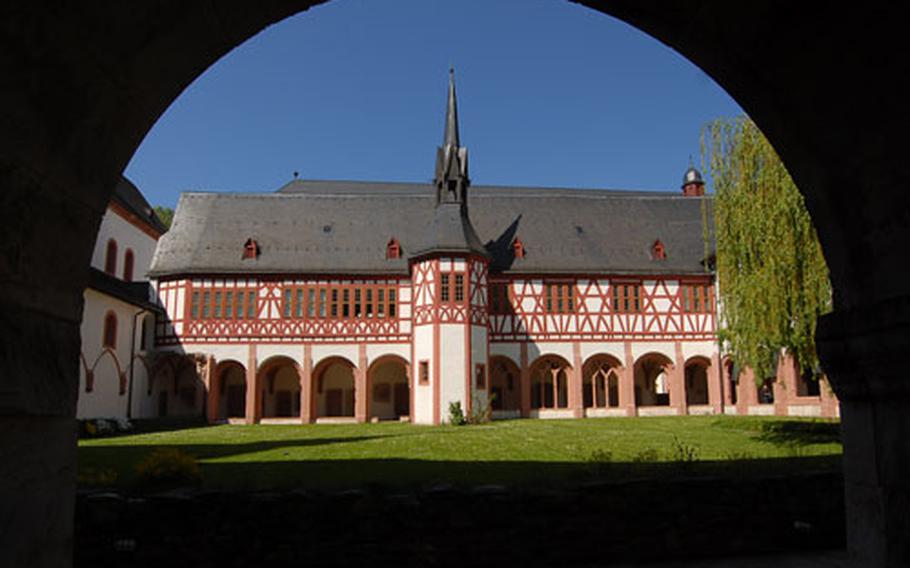
The view from one of the cloister arches at Kloster Eberbach shows the late-Gothic, half-timbered library. Today it houses the monastery museum. (Michael Abrams / S&S)
Tucked in the woods on a hillside above the Rhine River and the vineyards of Germany’s Rheingau is Kloster Eberbach.
Once a Cistercian monastery, today it is the headquarters of the Hesse state winegrowing estates, home to a noted Easter egg market and a popular tourist destination.
In the early 12th century, monks under Bernhard of Clairvaux were establishing monasteries across Europe. The order was known for its ascetic ways: cycles of sleep, prayer, work and singing praise continuing throughout the day. They were, however, hard workers and the monastery flourished. Agriculture was the mainstay of its wealth, especially viniculture. At its peak, about 150 monks and more than 400 lay brothers lived and worked at Kloster Eberbach.
As with many monasteries throughout central Europe, Kloster Eberbach’s fortunes rose and ebbed with the tides of history. Plundering and destruction followed religious and financial heydays.
It suffered through several wars before being secularized in 1803. In the 205 years since, it has served as a winery, prison, mental ward, convalescent home for soldiers and a setting for film and television. In 1985, many of the indoor scenes for "The Name of the Rose," starring Sean Connery, were filmed here.
A visit to the former monastery will take you to some of the best Gothic architecture around.
At its center is the cloister quadrangle, surrounding its garden. Along one side is a beautiful half-timbered building that once housed the library but is now home to the monastery museum.
From the cloister, a door leads into the chapter house. A meeting hall, its vaulted ceiling, much like an umbrella, rests on a single central pillar.
The monastery church, built in the 12th century, is — except for its tombs — without much adornment.
A stairway in the church leads to the monks’ dormitory. Here the monks slept, in the Spartan ways of the order, in their clothes, on pallets.
The hall, about 238 feet long, was built in the 13th and 14th centuries. It is considered one of the finest early Gothic rooms in Europe.
The museum, entered from the dormitory, houses many of the monastery’s original statues (the ones outside are copies), and traces monastery life.
Behind the cloister is a large building that was once used by the lay brothers. Their refectory now houses huge grape presses, the oldest dating to 1668.
The top floor of the building is the lay dormitory. At 274 feet, the vaulted room is the biggest secular Romanesque room in Europe. Unfortunately, it is not open to the public except on special occasions, such as wine auctions and the Easter egg market.
A tour through the monastery ends in the Fraternei, a Gothic room used by the monks as a workplace. It is lined with casks of wine, and is used today for wine tastings.
Directions: The monastery is on the outskirts of Kiedrich, Germany. From the Wiesbaden area, take Autobahn 66 toward Rüdesheim. The autobahn ends, turning into highway B42. Exit at Kiedrich, then follow brown Kloster Eberbach signs guiding the way through the town to the monastery. From the Kaiserslautern area, take A63 to Mainz, at the junction with A60, head toward Bingen and then connect with A643 to Wiesbaden. When it meets A66, follow the directions above.
Times: Open 10 a.m. to 6 p.m. daily until Oct. 28, with last admission at 5:30 p.m. From Oct. 29 to March 20, 11 a.m. to 5 p.m. daily with last admission at 4:30 p.m. Closed on Christmas Eve, Christmas and New Year’s Eve.
Costs: Admission is 3.50 euros (about $5.50) for adults and 1.50 euros for youths 12 to 18 years. An audioguide costs 3.50 euros. Parking is free.
Food: The Klosterschänke restaurant on the monastery grounds offers good food but is a little expensive. Soups are 4.90 euros, while a turkey schnitzel is 11.50.
Information: The monastery’s Web site is www.klostereberbach.de, with a link to English-language pages. You can buy wine from the Hesse wine estates at their shop in the monastery.